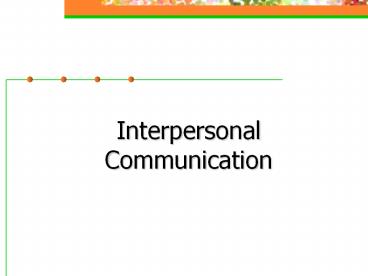Interpersonal Communication - PowerPoint PPT Presentation
Title:
Interpersonal Communication
Description:
Use a tone of voice that matches your message Positive Nonverbal Actions Include: Advice to Improve Nonverbal Communication Skills (cont) ... – PowerPoint PPT presentation
Number of Views:896
Avg rating:3.0/5.0
Title: Interpersonal Communication
1
Interpersonal Communication
2
A Perceptual Model of Communication
Receiverdecodes
Transmittedon medium
Message
Encoding
Sender
Receivercreatesmeaning
Noise
Sourcedecodes
Encoding
Message
Transmittedon medium
3
Sources of Distortion in Upward Communication
4
Communication Styles
Communication
Nonverbal Behavior Verbal Behavior
Style Description Pattern
Pattern
Direct and unambiguous language No attributions
or evaluations of others behavior Use of I
statements and cooperative we statements.
Good eye contact Comfortable but firm posture
Strong, steady and audible voice Facial
expressions matched to message Appropriately
serious tone Selective interruptions to ensure
understanding.
Pushing hard without attacking permits others to
influence outcome expressive and self-enhancing
without intruding on others.
Assertive
5
Communication Styles (continued)
Communication
Nonverbal Behavior Verbal Behavior
Style Description Pattern
Pattern
Glaring eye contact Moving or leaning too close
Threatening gestures (pointing finger clenched
fist) Loud Voice Frequent interruptions.
Swear words and abusive language Attributions
and evaluations of others behavior Sexist or
racists terms Explicit threats or put-downs.
Taking advantage of others Expressive and
self-enhancing at others expense.
Aggressive
6
Communication Styles (continued)
Communication
Nonverbal Behavior Verbal Behavior
Style Description Pattern
Pattern
Little eye contact Downward glances Slumped
postures Constantly shifting weight Wringing
hands Weak or whiny voice.
Qualifiers (maybe, kind of ) Fillers (uh,
you know, well) Negaters (its really not
that important, Im not sure).
Encouraging others to take advantage of us
Inhibited Self-denying.
Nonassertive
7
Communication is more than just verbal
- Nonverbal communication
- Words account for only 7 of emotional impact of
a message - Voice tones- 38
- Facial Expressions- 55
- High context vs. Low Context Cultures
8
Categories of Non-Verbal Messages
- Environment
- Interpersonal Distance
- Posture
- Gestures
- Facial Expressions
- Voice Quality
- Personal Appearance
9
Skills and Best Practices Advice to Improve
Nonverbal Communication Skills
Positive Nonverbal Actions Include
- Maintain eye contact.
- Nod your head to convey that you are listening
or that you agree. - Smile and show interest.
- Lean forward to show the speaker you are
interested. - Use a tone of voice that matches your message
10
Advice to Improve Nonverbal Communication Skills
(cont)
Negative Nonverbal Actions Include
- Avoiding eye contact and looking away from the
speaker. - Closing your eyes or tensing your facial
muscles. - Excessive yawning.
- Using body language that conveys indecisiveness
or lack of confidence (e.g., slumped shoulders,
head down, flat tones, inaudible voice) - Speaking too fast or too slow.
11
Listening Styles
Results-style Interested in the bottom line or
result of a message.
Reasons-style Interested in hearing the
rationale behind a message.
Process-style Likes to discuss issues in detail.
12
The Keys to Effective Listening
Keys to Effective Listening The Bad Listener The Good Listener
1. Capitalize on thought speed Tends to daydream Stays with the speaker, mentally summarizes the speaker, weighs evidence, and listens between the lines
2. Listen for ideas Listens for facts Listens for central or overall ideas
3. Find an area of interest Tunes out dry speakers or subjects Listens for any useful information
4. Judge content, not delivery Tunes out dry monotone speakers Assesses content by listening to entire message before making judgments
5. Hold your fire Gets too emotional or worked up by something said by the speaker and enters into an argument Withholds judgment until comprehension is complete
13
The Keys to Effective Listening (cont)
Keys to Effective Listening The Bad Listener The Good Listener
6. Work at listening Does not expend energy on listening Gives the speaker full attention
7. Resist Distractions Is easily distracted Fights distractions and concentrates on the speaker
8. Hear what is said Shuts our or denies unfavorable information Listens to both favorable and unfavorable information
9. Challenge yourself Resists listening to presentations of difficult subject manner Treats complex presentations as exercises for the mind
10. Use handouts, overheads, or other visual aids Does not take notes or pay attention to visual aids Takes notes as required and uses visual aids to enhance understanding of the presentation
14
Barriers to Effective Communication
- Process Barriers involve all components of the
perceptual model of communication - Personal Barriers involve components of an
individuals communication competence and
interpersonal dynamics between people
communicating - Physical Barriers pertain to the physical
distance between people communicating - Semantic Barriers relate to the different
understanding and interpretations of the words
we use to communicate - For class discussion Which of the barriers to
effective communication is the most difficult
to deal with? Explain.
15
Metacommunication
- Communicating about ones communication
style/barriers to communication, etc.
16
Gender Differences
- Women
- Prefer conversation for rapport building
- Want empathy, not solutions
- Are more likely to compliment
- Emphasize politeness
- More conciliatory
17
Gender Differences
- Men
- Talk as a means to preserve independence and
status by displaying knowledge and skill - Work out problems on an individualized basis
- Are more directive in conversation
- Are more intimidating
- Call attention to their accomplishments
- Tend to dominate discussions during meetings
18
Human Communication
- Men
- Lecture
- Seek facts
- Desire respect
- Interrupt more often
- Change topics more often
- Women
- Talk, not lecture
- Build relationships
- Want to be liked
- More patient
- More sensitive to emotions































